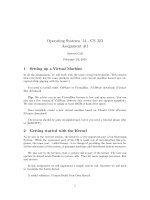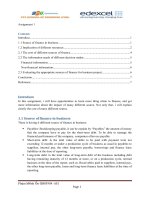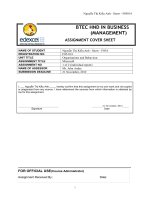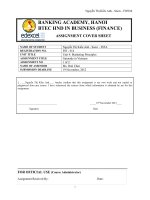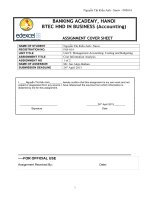1633 assignment 1 (pass)
Bạn đang xem bản rút gọn của tài liệu. Xem và tải ngay bản đầy đủ của tài liệu tại đây (895.42 KB, 30 trang )
Higher Nationals in Computing
UNIT 30
WEBSITE DESIGN & DEVELOPMENT
ASSIGNMENT
No.1
Learner’s name: ĐÀO VĨNH KHANG
Assessor name: TRUNG NAM
Class: GCS0905B
Learner’s ID: GCS200222
Assignment due:
Assignment submitted:
ASSIGNMENT 1 FRONT SHEET
Qualification
BTEC Level 5 HND Diploma in Computing
Unit number and title
10: Website Design & Development
Submission date
Date Received 1st submission
Re-submission Date
Date Received 2nd submission
Student Name
ĐÀO VĨNH KHANG
Student ID
GCS200222
Class
GCS0905B
Assessor name
TRUNG NAM
Student declaration
I certify that the assignment submission is entirely my own work and I fully understand the consequences of plagiarism. I understand that
making a false declaration is a form of malpractice.
Student’s signature
Grading grid
P1
P2
P3
P4
M1
KHANG
M2
M3
D1
Summative Feedback:
Grade:
Signature & Date:
Resubmission Feedback:
Assessor Signature:
Date:
Assignment Brief 1 (RQF)
Higher National Certificate/Diploma in Computing
Student Name/ID
Number:
Unit Number and Title:
Unit 10: Website Design & Development
Academic Year:
2021 – 2022
Unit Assessor:
Hoang Nhu Vinh
Assignment Title:
Web Technologies
Issue Date:
01 April 2021
Submission Date:
Internal Verifier Name:
Date:
Submission Format:
Format: The submission is in the form of two documents/files
● A ten-minute Microsoft® PowerPoint® style presentation which can be shared
with your colleagues for feedback. The presentation can include links to
performance data with additional speaker notes and a bibliography using the
Harvard referencing system. The presentation slides for the findings should be
submitted with speaker notes as one copy.
● An extended guidebook or detailed report that provides more thorough,
evaluated or critically reviewed technical information on all of the topics
covered in the presentation.
Submission
● Students are compulsory to submit the assignment in due date and in a way
requested by the Tutor.
● The form of submission will be a soft copy posted on
/>● Remember to convert the word file into PDF file before the submission on CMS.
Note:
● The individual Assignment must be your own work, and not copied by or from
another student.
● If you use ideas, quotes or data (such as diagrams) from books, journals or
other sources, you must reference your sources, using the Harvard style.
● Make sure that you understand and follow the guidelines to avoid plagiarism.
Failure to comply this requirement will result in a failed assignment.
Unit Learning Outcomes:
LO1 Explain server technologies and management services associated with hosting
and managing websites.
LO2 Categorise website technologies, tools and software used to develop websites.
Assignment Brief and Guidance:
You currently work for a software training company that produces courses and topic
presentations to established companies and, importantly, to new start-ups. MWS
wishes to pursue a bespoke web-based e-commerce solution. As part of your role,
you have been asked to create an engaging presentation to help inform and train staff
members on the tools and techniques associated with front- and back-end
development together with the technologies and services required to set up, host and
manage a typical commercial website. You will find more information in the file
MWSCaseStudy.docx.
In addition to your presentation, you will also provide an extended guidebook
containing further information for staff members or a detailed report containing a
technical review of the topics covered in the presentation.
TASK 1 Your presentation should include:
1. Server technologies and the management services associated with hosting and
managing websites.
2. A review of different website technologies supported with the tools and software
used to develop websites (including the differences between online website creation
tools and custom-built sites).
TASK 2 Write a guidebook
Your extended guidebook or detailed report should include a summary of your
presentation as well as additional, evaluated or critically reviewed technical notes on
all the expected topics.
Learning Outcomes and Assessment Criteria (Assignment 1):
Learning Outcome
LO1
Pass
Merit
Distinction
P1 Identify the
purpose and types
of DNS, including
explanations on
how domain
names are
organized and
managed.
M1 Evaluate the
impact of
common web
development
technologies and
frameworks with
regards to website
design,
functionality, and
management.
D1 Justify the
tools and
techniques chosen
to realize a
custom-built
website.
P2 Explain the
purpose and
relationships
between
communication
protocols, server
hardware,
operating systems,
and web server
software with
regards to
designing,
publishing, and
accessing a
website.
M2 Review the
influence of search
engines on website
performance and
provide
evidencebased
support for
improving a site’s
index value and
rank through
search engine
optimization.
LO2
P3 Discuss the
capabilities and
relationships
between frontend
and back-end
website
technologies and
explain how these
relate to
presentation and
application layers.
P4 Discuss the
differences
between online
website creation
tools and
custombuilt sites
with regards to
design flexibility,
performance,
functionality, User
Experience (UX)
and User
Interface (UI).
M3 Evaluate a
range of tools and
techniques
available to design
and develop a
custombuilt
website.
Table of Content
P1. Identify the purpose and types of DNS, including explanations on how domain names are organized and
managed……………………………………………………………………………………………………………..1
1/ DNS………………………………………………………………………………………………………………..1
2/ DNS Server Types and Roles…………………………………………………………………………………….2
2.1. Root Name Servers……………………………………………………………………………………………..2
2.2. DNS Recursor…………………………………………………………………………………………………...3
2.3. TLD Nameserver………………………………………………………………………………………………..3
2.4. Authoritative Nameserver……………………………………………………………………………………...4
P2. Explain the purpose of the software…………………………………………………………………………...4
1/ Explain of Communication Protocol……………………………………………………………………………5
2/ Explain of Server hardware……………………………………………………………………………………..5
3/ Explain of Operating systems……………………………………………………………………………………6
4/ Explain of Web server software………………………………………………………………………………….6
P3. Discuss the capabilities and relationships between front-end and back-end website technologies ……….6
1/ Front-end …………………………………………………………………………………………………………7
2/ Back-end………………………………………………………………………………………………………….8
3/ Relationships between front-end and back-end website technologies………………………………………..8
P4. A review of different website technologies supported with the tools and software used to develop
websites……………………………………………………………………………………………………………..10
1/ Front End technologies………………………………………………………………………………………….10
2/ Back End technologies…………………………………………………………………………………………..11
3/ Database………………………………………………………………………………………………………….13
4/ IDE……………………………………………………………………………………………………………….13
5/ CMS………………………………………………………………………………………………………………15
Assignment
P1/ Identify the purpose and types of DNS, including explanations on how domain names are
organized and managed.
1/ DNS
1.1/ Definition
DNS (Domain Name System) or domain name resolution system, can be explained as a system that helps humans and computers
"communicate" with each other more easily (Because of their communication language). we are names and letters, and
computers can only understand sequences of numbers!) The system helps to translate domain names (hostnames) into strings
of numbers, so that computers can understand.
1.2/ Target of DNS
The domain name system is like a phone book. That is, instead of having to remember dozens of phone numbers with a bunch
of numbers, you just need to remember the name of the owner of the phone number. In that case, the phone number will
correspond to the IP address of the Website, and the owner's name is the domain name of that website.
For example, when you type “www.google.com” into your browser, the DNS server will get the address of the Google server as
“74.125.236.37”. You will then see the Google home page load the page on the browser you are using. That's the DNS resolution
process.
2/ DNS Server Types and Roles
2.1. Root Name Servers
Also commonly referred to as Name Server. This is the most important server in the DNS hierarchy. You can also understand
that Root Name Server is a library to guide your search.
Following the actual process, after receiving a request from the DNS Recursive Resolver, the Root Name Server will respond that
it should look in specific top-level domain name servers (TLD Name Servers).
2.2. DNS Recursor
As mentioned above, this "hardware" acts as a diligent worker, taking on the task of retrieving and returning information to the
browser to find the right information they need. In other words, DNS Recursor is responsible for communicating with other
servers to respond to the user's browser. Of course, in the process of getting information, sometimes it will also need the help of
Root DNS Server.
2.3. TLD Nameserver
When you want to access Google or Facebook, usually, your extension will be “.com” right? So, I want you to know that it is one
of the Top-level Domains. And the Server for this type of Top-level domain is called TLD Nameserver. This is the manager of the
entire information system of a common domain name extension.
In sequence, the TLD Name Server responds from the DNS Resolver, then presents it to an Authoritative DNS Server – or the
official repository of that domain's data source.
2.4. Authoritative Nameserver
When the DNS Resolver finds the Authoritative Nameserver, that's when the domain name resolution takes place.
The Authoritative Name Server, on the other hand, contains information that indicates what address the domain name is
associated with. It will provide the Recursive Resolver with the necessary IP address found in its records directory.
P2/ Explain the purpose and relationships between communication protocols, server hardware,
operating systems, and web server software with regards to designing, publishing, and accessing a
website.
1/ Explain of Communication Protocol 1.1/ Definition
Communication protocols are formal descriptions of digital message formats and rules. They are required to exchange messages
in or between computing systems and are required in telecommunications. Communications protocols cover authentication,
error detection and correction, and signaling. They can also describe the syntax, semantics, and synchronization of analog and
digital communications. Communications protocols are implemented in hardware and software. There are thousands of
communications protocols that are used everywhere in analog and digital communications. Computer networks cannot exist
without them.
1.2/ Purpose
Communication devices must agree on many physical aspects of the data being exchanged before successful transmission can
occur. Internal transmission rules are called protocols. There are many attributes of a transmission that a protocol can define.
Common ones include packet size, transfer rate, error correction types, handshake and synchronization techniques, address
mapping, recognition process, flow control, packet self-control, routing, address format.
2/ Explain of Server hardware
2.1/ Definition
The main server is a complex system that has the task of centrally storing data sources, processing, and accessing information coming
from other computers over the Internet. The server hardware equipment for a complete setup is like a desktop computer (also known
as a PC).
2.2/ Purpose
Servers often operate for a long time, without interruption, requiring very high availability, so hardware reliability and durability
are extremely important criteria. Because of this, when choosing a server, users should choose branded and reputable lines.
Many server hardware configurations take a long time to boot and load the operating system. Servers typically do preboot
memory checks and start remote management services.
The hard-drive controllers then start the drives sequentially, but not all at once, so as not to overload the power supply with
incremental boot, and then they start running to the system. RAID requires checks for the correct operation of the backup device.
It may take longer than a computer that takes only a few minutes to boot, but it may not need to be restarted for months or years.
3/ Explain of Operating systems
3.1/ Definition
Operating system (abbreviated: OS), in the most general sense, is software that allows users to run other applications on a
computer device, mobile device through hardware such as CPU, RAM, ROM, screen. ... Although software applications can
communicate directly with hardware, most applications are always written for an operating system, allowing them to take
advantage of common libraries without having to worry about other operating systems. specific hardware details.
3.2/ Purpose
The operating system consists of many components and features. What features are defined as part of the operating system will
vary from operating system to operating system. However, the three components that are easiest to identify are:
•
Kernel: The kernel provides basic level controls over all computer hardware devices. Key roles include: reading data from
memory and writing data to memory, processing execution instructions, defining how data is received and sent by
devices such as monitors, keyboards, mice, and monitors. defines how to interpret data received from the network.
•
User Interface: The User Interface allows interaction with the user through graphical icons and a desktop or through a
command line.
•
Application Programming Interfaces: Application Programming Interfaces allow application developers to write modular
code.
•
•
Examples of operating systems include: Android, iOS, Mac OS X, Microsoft Windows, and Linux.
Operating system features
•
•
•
An operating system is a program that acts as an interface between computer software and hardware.
It is a set of integrated specialized programs used to manage the overall resources and operation of the computer.
It is a specialized piece of software that controls and monitors the execution of all other programs located in the computer,
including application programs and other system software.
4/ Explain of Web server software
4.1/ Definition
The web server is connected and linked to an extended computer network. Web servers are installed with programs to serve
web applications, contain all the data and take control. The web server can take requests from the web browser and send
the response back to the client via HTTP or another protocol.
4.2/ Purpose
"Server" is understood to mean:
•
Hardware configuration "Physical server". There are famous server manufacturers such as Dell servers, HP servers,
IBM servers, Supermicro servers. This physical server needs to install additional software to be able to use it. The
server can have many CPUs (currently up to 200 cores), many Ram sticks (currently 6144GB Ram can be installed /
1 server), hard drives can install up to several hundred TB / 1 server .
•
or understood in terms of software - A server is a place to store / Install software programs so that many workstations
can access the centralized data storage place through the internet. Server in this sense can be "cloud vps" or even
Hosting service. But it can also be a system that includes a LOT of servers from all over the world, for example "google
servers" means hundreds of thousands of servers all over the world.
P3. Discuss the capabilities and relationships between front-end and back-end website technologies.
1/ Front-end
1.1/ Definition
The front-end part of a website is the part that interacts with the user. Everything you see when you navigate the Internet, from
fonts and colors to drop-down menus and sliders, is a combination of HTML, CSS, and JavaScript controlled by your browser.
friend.
Front-end developers are responsible for the look and feel of a website and the architecture of the user experience. To
accomplish those goals, front-end developers must master three main languages: HTML, CSS, and the JavaScript programming
language.
1.2/ Skills and tools
Good front-end developers can also pinpoint specific issues in the user experience, providing recommendations and
systematized solutions to influence that design. Crucially, they have the ability to work with other groups in the company to
understand their specific goals, needs, and opportunities, and then follow through on those directions.
This job involves a lot of responsibility, but it's well worth it. “I am a technical person, but still a visual person, and can manipulate
what we see and interact with digital platforms through markup and code spontaneously. course,” said Mikey Ilagan, a frontend
developer with eight years of experience. “Because of that, I would love to have the ability to make an impact on the user
interface, the aspects of an app or website that users interact with and see.”
2/ Back-end
2.1/ Definition
What is backend? But what makes the front-end part of a website work? Where will all the data be stored? That's the back-end’s job.
The back end of a website includes a server, an application, and a database. A back-end developer builds and maintains the technology
that, the power of those components, enables the user interface part of a website to live on.



